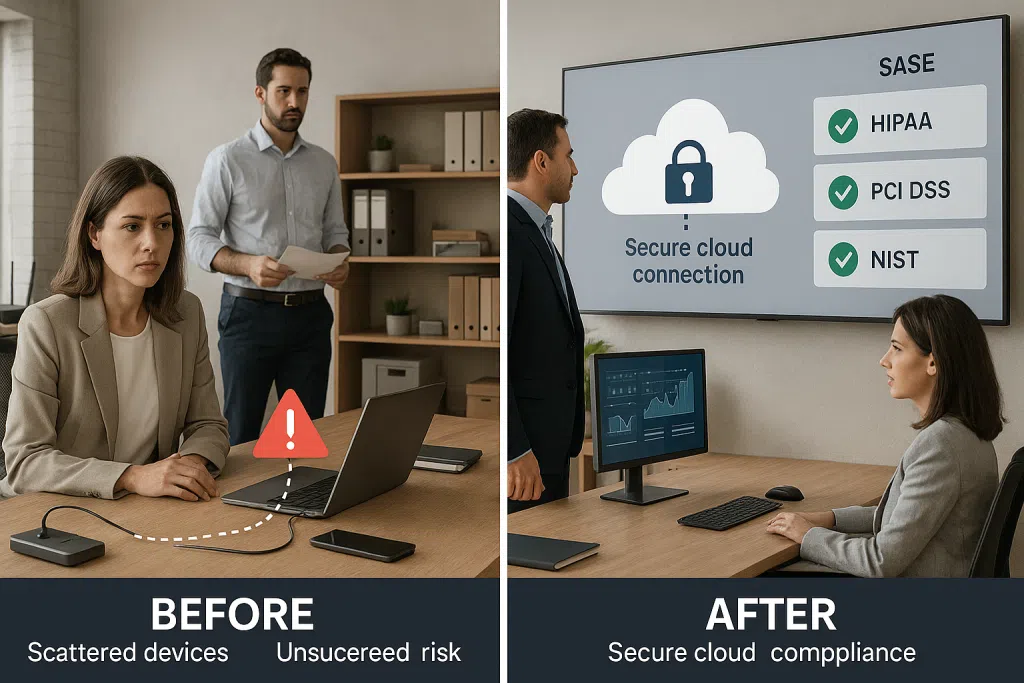Understanding SASE Network Architecture and Its Impact on Modern Security
Today’s regulated businesses, whether medical practices navigating HIPAA rules, finance teams safeguarding sensitive information, or law firms confronting evolving cyber threats, face a simple reality: legacy security models no longer cut it. As operations expand, cloud adoption accelerates, and remote work becomes standard, traditional “castle-and-moat” perimeters prove rigid and inadequate. Enter SASE network architecture, or Secure Access Service Edge: a powerful, cloud-centric framework reshaping how organizations manage network access, cybersecurity compliance, and risk.
SASE (pronounced “sassy”) combines essential network functions, like secure web gateways (SWG), cloud access security brokers (CASB), firewalls as a service (FWaaS), and zero-trust network access (ZTNA), within a unified, cloud-delivered service model. In practice, this means a single, scalable platform handling all network security, access control, and compliance enforcement from any device, branch, or remote user.
For healthcare practices balancing patient privacy, legal firms seeking airtight confidentiality, and financial SMBs required to meet exacting regulatory standards, SASE network architecture offers a leap in operational safety and compliance. It’s especially meaningful for small to mid-sized enterprises (SMBs) in New Jersey, Pennsylvania, and the NYC metro, where regulatory compliance isn’t optional.
Why is SASE so relevant now? Three shifts explain its rise:
- Cloud-first applications and SaaS platforms are business-critical for everything from electronic health records to financial management.
- Hybrid and remote work demand secure, agile access from anywhere, not just the corporate headquarters.
- Regulatory expectations (think HIPAA, FINRA, PCI-DSS) are stricter than ever. Demonstrated cybersecurity compliance is a contractual necessity.
By adopting secure access service edge strategies, organizations can centralize cybersecurity policy, gain real-time visibility, and ensure that only authorized users and devices connect, regardless of network, device, or location. In doing so, SASE network security provides tangible value: it reduces breach risks, simplifies compliance, and streamlines technology operations.
If your SMB is ready to simplify complex security frameworks or needs a strategy tailored for healthcare, finance, legal, or pharmaceutical compliance in New Jersey and beyond, book an initial Discovery meeting with Blueclone Networks here.
Let’s unravel how SASE works, why it’s essential for regulated businesses, and how this architectural shift modernizes both security and compliance.
How Does SASE Work? Core Components and Architecture Explained
SASE network architecture is more than a tech buzzword, it’s an architectural blueprint that fuses critical network and security tools within a cloud-native approach. Understanding its main components clarifies why it’s especially effective for multi-site, heavily regulated SMBs.
The Core Elements of SASE
Software-Defined Wide Area Network (SD-WAN):
- SD-WAN routes traffic intelligently over multiple connections (MPLS, broadband, LTE, etc.), optimizing performance based on application, user, and compliance needs. Unlike legacy WANs, SD-WAN is cloud- and mobility-friendly, supporting access from anywhere.
Zero Trust Network Access (ZTNA):
- ZTNA ensures that no device or user is automatically trusted, even if they’re inside the business network. Instead, access depends on granular verification, user identity, context, device health, and behavioral signals. Fine-tuned policies specify who can access what, when, and from where.
Secure Web Gateway (SWG) & Firewall as a Service (FWaaS):
- These provide real-time inspection of internet-bound traffic and block malicious sites, downloads, or applications at the cloud edge. Unlike on-premise firewalls, FWaaS and SWG remain effective regardless of user location, keeping travel or home-office traffic fully protected.
Cloud Access Security Broker (CASB):
- CASB solutions sit between users and cloud applications (Microsoft 365, Google Workspace, Salesforce, etc.), detecting risky usage, enforcing data loss prevention (DLP), and blocking unauthorized file sharing. For regulated sectors, CASB is vital for privacy and compliance.
Data Loss Prevention (DLP) & Threat Intelligence:
- SASE integrates advanced DLP controls, proactively stopping the movement of confidential data outside allowed channels. When combined with continuous threat intelligence, these features catch previously unknown malware or subtle insider risks.
How These Pieces Work Together
What sets the SASE security framework apart is its integration. Rather than stack separate point tools, all these controls are delivered together in the cloud. Every connection, whether from a hospital site, a remote legal associate, or a pop-up pharma workspace, is inspected and policy-enforced through a global SASE fabric.
This consolidated, always-on inspection model means:
- No more security gaps when users roam outside the firewall.
- Simplified rule management: Write a policy once, apply it everywhere, headquarters, branches, home offices, or mobile devices.
- Instant scalability: Onboard new apps, users, or remote locations without buying extra appliances or hiring more IT headcount.
For organizations with tight internal IT teams or those co-managing IT with partners like Blueclone Networks, SASE’s consolidated architecture frees resources to focus on strategic growth, not daily firefighting.
SASE network security is designed to flex with both the business and the threat landscape, whether you’re supporting telehealth visits, secure loan applications, or cross-border deal negotiations.
Why SASE Is the New Cybersecurity Compliance Standard for Healthcare, Legal, and Finance
Digital transformation and regulatory scrutiny often pull regulated SMBs in different directions. The growing patchwork of privacy laws (HIPAA, PCI-DSS, GLBA, GDPR) requires proof that data is secure everywhere, not just in the server room. SASE network architecture answers this challenge by enforcing compliance at every network edge.
SASE and HIPAA, HITECH, and PCI-DSS: A Compliance-First Approach
Healthcare organizations must control access to electronic protected health information (ePHI), monitor all data flows, encrypt sensitive records in transit, and document breach attempts, all while supporting telemedicine, remote work, and multiple cloud apps.
With SASE, these requirements become manageable. ZTNA policies confirm that only authorized, authenticated users and devices can access ePHI, regardless of where they log in. SWG and DLP prevent accidental uploads of files with patient data to unsanctioned cloud apps, while real-time logs help with audit trails.
The same advantages apply to legal and financial firms with comparable mandates under FINRA, SOX, or GLBA. SASE enables policy-driven access controls for case files, contracts, and financial records, proactively blocks malware and phishing attempts, and provides centralized compliance reporting.
Achieving Continuous Compliance With SASE
A key challenge in regulatory sectors is maintaining “continuous compliance”, not just at audit time, but every day. Traditional IT stacks often force teams to stitch together logs, firewall settings, and third-party reports across scattered devices and locations.
SASE security frameworks centralize this effort. Because all controls are delivered from the cloud, IT leaders have consistent reporting and alerting about who accessed what, when, and how. Updates to access policies, DLP rules, or encryption settings can be rolled out instantly across every user, on-site or remote.
According to Gartner’s 2024 Market Guide for SASE, organizations using unified secure access service edge platforms saw a 35% decrease in compliance-related incidents compared to those relying on traditional, siloed solutions. This improvement came largely from streamlined policy enforcement and real-time visibility into user activities.
As a result, SASE offers more than security, it provides the accountability, documentation, and control required to satisfy auditors, regulators, and risk-conscious clients. This is particularly relevant for SMBs that lack the budget for big in-house compliance teams.
Ready to see how SASE could simplify your compliance workload and reduce risk? Book an initial Discovery meeting today.
Centralizing Cybersecurity Policy: SASE Network Security in Action
At its heart, SASE network security is about seamless policy orchestration and real-time threat defense, no matter where data lives or travels. Let’s see how this plays out in daily business scenarios for highly regulated organizations.
Scenario 1: Healthcare Practice Enabling Remote Consultations
When the COVID-19 pandemic prompted a surge in telemedicine, many practices scrambled to secure home-based devices and personal laptops. SASE’s zero-trust model and centralized controls allow medical staff to securely connect to electronic health records from any device, any location, with real-time policy enforcement. IT can ensure that access is tightly restricted, sessions are encrypted, and all activity is logged for later audits.
A major New Jersey orthopedic clinic implemented SASE to allow 45 providers to consult remotely with full HIPAA safeguards and now reports fewer data loss incidents and a simpler compliance effort, according to their IT team.
Scenario 2: Law Firm Protecting Confidential Attorney-Client Communications
Legal teams must shield sensitive case documents, emails, and communications from cyberattacks and unauthorized leaks. With SASE in place:
- All file transfers to cloud storage undergo real-time scanning for confidential keywords or policy violations.
- External sharing links are automatically disabled for privileged documents.
- If a compromised credential is detected (e.g., a leaked password), ZTNA blocks the attack before any client files are accessed.
Scenario 3: Financial SMB Adopting Cloud Platforms
A growing accounting firm shifted from on-premise file servers to a combination of Microsoft 365, a cloud-based accounting suite, and custom SaaS tools. SASE’s integrated CASB allowed secure authentication, monitoring for unauthorized data movement, and DLP controls, ensuring customer Social Security Numbers or tax forms never left approved platforms.
In each of these examples, the move to SASE network architecture not only improves security but also enhances the business’s day-to-day agility and supports new digital workflows. Security and productivity are no longer opposing forces.
SASE Security Framework: Implementation Pathways and Best Practices
Migrating to a SASE security framework can appear complex. But stepwise planning, especially in environments with compliance mandates, enables a smooth transition with minimal disruption.
1. Define Core Business and Compliance Objectives
Understand which assets require the strongest protection (patient health data, legal correspondence, financial records), and map out regulatory requirements (HIPAA, PCI, FINRA). Prioritize applications and locations (physical offices, remote workers, cloud platforms) based on business impact.
2. Assess Existing Infrastructure and Security Gaps
Identify current tools in use: firewalls, VPNs, web gateways, endpoint protection agents, and how these connect existing assets. Pinpoint gaps, especially unsecured cloud apps, remote workers outside legacy VPN coverage, or a lack of unified logging.
3. Choose the Right SASE Solution
Evaluate SASE offerings based on:
- Integration with cloud apps: How well does the platform secure Microsoft 365, Google Workspace, Dropbox, etc.?
- Granularity of policy controls: Can you specify access rules per user, device, application, or location?
- Visibility and reporting: Does the solution offer centralized dashboards and compliance-ready audit logs?
- Regulatory alignment: Is the provider experienced in HIPAA IT compliance or other relevant standards?
Working with a managed IT partner, like Blueclone Networks, ensures you align technical solutions with business needs and compliance demands.
4. Implement in Stages
Start by migrating a specific group, perhaps remote users or a cloud-hosted document management solution, to the SASE platform. Monitor results, tune policies, and then extend to wider locations, more users, and additional cloud apps.
5. Train Users and IT Staff
The best SASE systems are only as effective as the people who use them. Conduct brief training for employees on safe connection practices and recognizing security alerts. For internal IT teams, ensure familiarity with policies, dashboards, and reporting workflows.
6. Continuous Review and Improvement
Regulations and threat landscapes evolve, so revisit policies and controls quarterly. Leverage built-in analytics to spot emerging risks, and use compliance reports to prepare for audits or demonstrate due diligence to clients.
A recent 2024 ISACA report highlighted a 40% improvement in incident response times among SMBs adopting unified SASE models compared to those juggling multiple, disconnected security tools. View ISACA’s analysis here.
The end result: a business with reduced risk, lower IT management burden, and continuous regulatory compliance. If you’re wondering how quickly your own organization could benefit, and what resources you need, schedule a Discovery meeting to start your assessment now: Book here.
Real-World Risks Without SASE Network Architecture
While some organizations still rely on a patchwork of legacy appliances, VPNs, and manual security monitoring, the risks are increasing, and so is the cost of inaction.
Top Threats Facing Regulated SMBs Without SASE
- Unsecured Remote Access: VPNs often require full network access, inadvertently exposing sensitive data to compromised endpoints. SASE offers granular, least-privilege access instead, minimizing exposure.
- Cloud Application Shadow IT: Employees using unsanctioned cloud storage, chat, or email tools risk data exfiltration or compliance violations. SASE’s CASB monitors and controls this “shadow IT.”
- Lack of Continuous Compliance Reporting: Disconnected logs and event data hinder the timely detection of suspicious activity or audit preparation, leaving firms exposed during a breach or compliance event.
- Manual Policy Updates: Traditional security stacks make it difficult to roll out urgent rules or respond to new threats; SASE’s centralized architecture enables instant, organization-wide policy enforcement.
- Escalating Costs and Complexity: Maintaining and monitoring on-premise appliances across multiple sites is both expensive and a drain on internal IT resources. SASE’s cloud-native approach reduces hardware capital costs and enables predictable, scalable subscriptions.
The practical consequences? A 2024 Cyentia Institute study found businesses with disconnected, perimeter-based security spent 55% more annually on compliance activities than those leveraging SASE frameworks. In addition, regulatory fines and reputational damage from breaches rose dramatically in healthcare and legal sectors.
How SASE Network Security Responds
SASE stands out for enabling centralized policy, streamlined compliance documentation, and real-time response to cyber risks, from ransomware to credential theft. More importantly, it allows SMBs to refocus internal IT effort from constant firefighting to strategic growth initiatives, confident that security is always “on.”
For organizations balancing budget realities, regulatory mandates, and business growth, the business case for SASE network architecture becomes clear: improved security, operational agility, and regulatory assurance are all within reach.
FAQs About SASE Network Architecture, Security, and Compliance
SASE network architecture (Secure Access Service Edge) integrates network connectivity and security functions, like firewalls, web gateways, and access controls, within a unified, cloud-delivered platform. Unlike traditional setups that rely on hardware appliances and static perimeters, SASE provides continuous, identity-based access and real-time security no matter where users or data reside. This approach is more flexible, scalable, and resilient for cloud-first, hybrid, and remote business environments.
SASE centralizes and automates key compliance controls: user authentication, data encryption, granular permissions, audit trails, and continuous threat monitoring. Policy changes can be deployed instantly across all users, cloud apps, and locations. This streamlines compliance with healthcare privacy laws, financial regulations, and legal confidentiality requirements, all from a single, managed platform.
SMBs, particularly those in regulated industries, benefit substantially from SASE. The architecture reduces complexity, eliminates the need for multiple overlapping tools, and adapts quickly to new threats or compliance requirements. Even organizations with small IT teams or co-managed setups can manage a robust SASE framework with far less effort, freeing resources to support business growth.
Yes. SASE’s zero-trust approach and cloud-native controls extend security and access policies to any user, device, or location. Whether users connect from company offices, home internet, or mobile hotspots, SASE enforces identity-based validation, encryption, and continuous monitoring, ensuring data security and compliance at all times.
Begin by identifying business-critical data, compliance mandates, and current security gaps. Blueclone Networks provides hands-on consulting, SASE platform selection guidance, staged migration planning, and ongoing managed services for New Jersey-area SMBs in healthcare, finance, legal, and pharmaceuticals. To discuss how SASE could align with your goals, you can book an initial Discovery meeting here.





